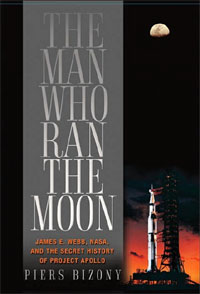Review: The Man Who Ran the Moonby Eve Lichtgarn
|
| With a graceful use of research, Bizony demonstrates how Webb steered NASA through the morass of politics, special interests, profiteering, untested systems, budget restrictions, volatile personalities, and other real world impediments. |
In 1961, when Webb took the reigns, “the image of NASA in the public imagination was somewhat more unified than the real thing,” Bizony writes. “America’s ‘space agency’ consisted, in truth, of argumentative and independently-minded fiefdoms, far apart in geography, history and tradition, each with a different view of priorities in space and on the ground, and each relying on support (or drawing flack) from a different set of senators and members of Congress.” Webb was in his element. Even though Bobby Kennedy called him nothing but “a blabbermouth,” Webb was as canny a political operative as Washington had seen.
With a graceful use of research, Bizony demonstrates how Webb steered NASA through the morass of politics, special interests, profiteering, untested systems, budget restrictions, volatile personalities, and other real world impediments until his early departure from the agency in 1968. Much of Bizony’s primary source material for this un-footnoted but thoroughly annotated biography comes from presidential library archives, oral histories, and personal interviews. Although Bizony maintains a professional distance from his narrative, it is clear that he is fond of his biographic subject and the result is refreshing. He writes, “Apollo was supposed to achieve more than merely its mechanistic function of reaching the moon. At least, that was Webb’s vision for the project. Few people working alongside him ever quite grasped the scale of his ideas. He was a twentieth-century technocrat in the fullest and perhaps most vainglorious sense. He campaigned throughout the Apollo years for a new brand of ‘space-age management’ in many areas of national life, not just in rocket development. And he wanted this transformation to start with the college kids.” We learn of Webb’s crusade to enrich education in America through progressive concepts designed to cross-pollinate universities, government and the private sector. We hear, perhaps for the first time, of Webb’s pet project called the Sustaining University Program, which would enable lesser-known universities to entice qualified students through grants and fellowships.
Lurking just ahead of these noble ideas is the terrible Apollo 1 fire. “As Webb went on the lecture trail to universities, private corporations, and chambers of commerce around the country, selling his grand ideas of Space Age Management to anyone who’d listen, his gravest error was to be seduced by dreams while losing touch with hard metallic engineering realities on the ground,” says Bizony. The proceedings of the congressional investigation into the fire effectively ended Webb’s career. His offer of resignation was rushed through by President Johnson before Webb had a chance to tell his own wife.
Bizony’s only misstep in this biography is a detour into the tale of Fred Black and the NASA vending machine scandal that always seems to dead end in every book that mentions this non-event. Otherwise, Bizony presents his work in the correct spirit. “The significant legacy of Webb’s NASA is not technological but moral. He and his federally employed colleagues were unafraid to accept responsibility for their appointed tasks, whether in luminous success or scalding failure. This lesson, above all, needs to be retained from the lunar adventure. As we send Apollo’s machines to the museum, we should keep alive the memory of its people.”
